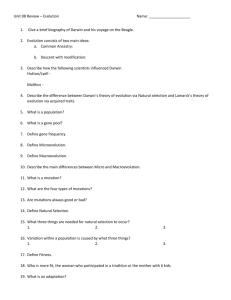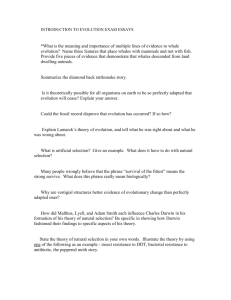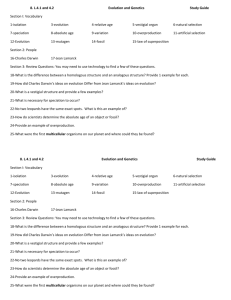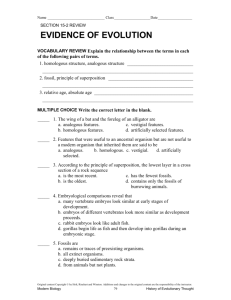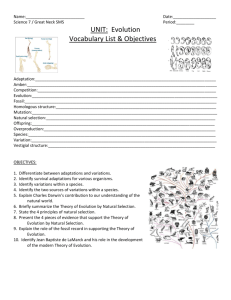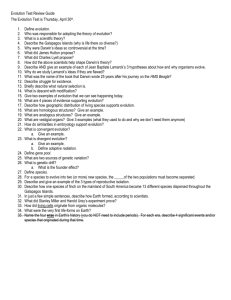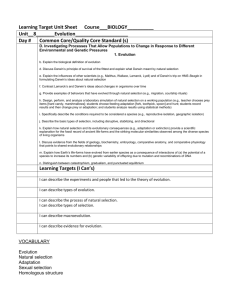Evolution Study Guide: Natural Selection & Adaptation
advertisement
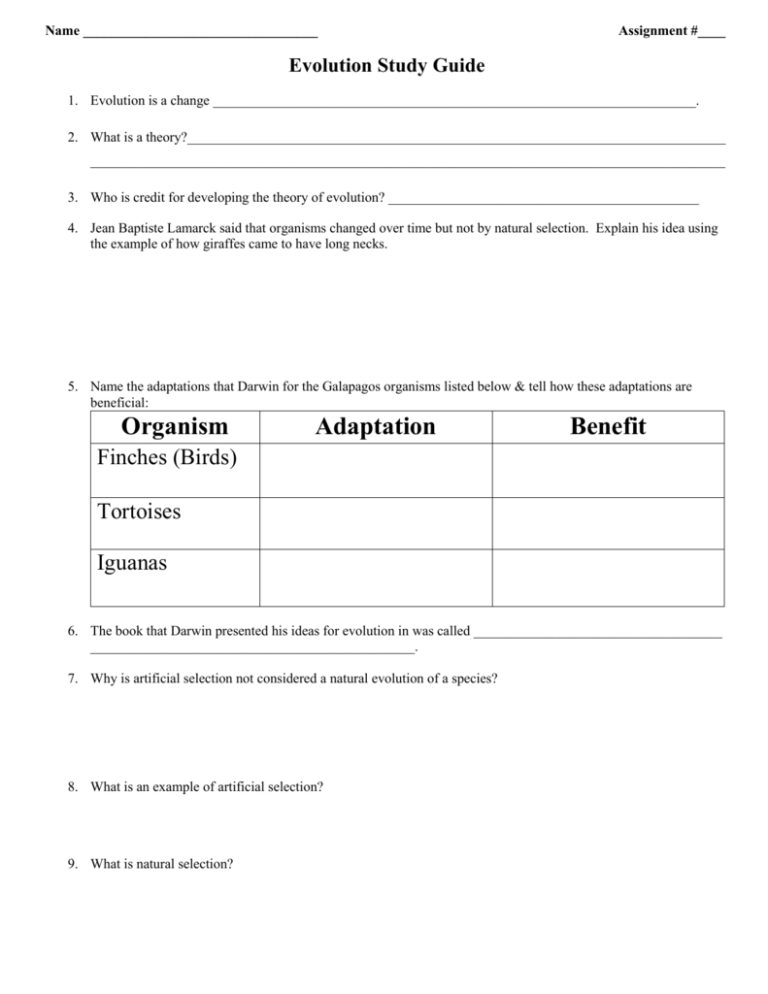
Name __________________________________ Assignment #____ Evolution Study Guide 1. Evolution is a change ______________________________________________________________________. 2. What is a theory?______________________________________________________________________________ ____________________________________________________________________________________________ 3. Who is credit for developing the theory of evolution? _____________________________________________ 4. Jean Baptiste Lamarck said that organisms changed over time but not by natural selection. Explain his idea using the example of how giraffes came to have long necks. 5. Name the adaptations that Darwin for the Galapagos organisms listed below & tell how these adaptations are beneficial: Organism Adaptation Benefit Finches (Birds) Tortoises Iguanas 6. The book that Darwin presented his ideas for evolution in was called ____________________________________ _______________________________________________. 7. Why is artificial selection not considered a natural evolution of a species? 8. What is an example of artificial selection? 9. What is natural selection? 10. What are the four steps of natural selection in order? a. _____________________________________________________________________________________ b. _____________________________________________________________________________________ c. _____________________________________________________________________________________ d. _____________________________________________________________________________________ 11. What ultimately causes some organisms to survive and others to perish? _________________________________ 12. What coloration of English Peppered Moths were more common prior to 1850?____________________________ After 1860? _______________________________________ 13. What caused the change in the population of European Peppered Moths during the 1850s? (Include the reason for the change in environment and why one was favored over an other at certain times) 14. Describe how Lamarck would explain the evolution of giraffe’s long necks vs. Darwin’s explanation. Lamarck Darwin 15. What is the relationship between evolution and natural selection? ______________________________________ ________________________________________________________________________________________________ ________________________________________________________________________________________________ 16. Which of the parent birds shown below (A or B) appears to have greater fitness? Explain your answer. ________________________________________________________________________________________________ 17. Which fossil is the a. Oldest? b. Youngest? 18. Describe how the following skeletal structures are similar. What do we call these similar structures? 19. When trying to determine the evolutionary relationship between two species, would a biologist concentrate on homologous features or analogous features? Explain why. 20. What are analogous structures and give an example? 21. How can DNA help to identify common ancestors? 22. Which two species are the most closely related? 23. Why are humans’ embryonic structures more similar to a pig than a chicken? 24. If an animal has a vestigial structure, what might a biologist infer about the animal’s evolutionary history? 25. What evidence supports that whales were once land dwelling animal? 26. What are the two types of evolution & explain them? a. _____________________________________________________________________________________ _____________________________________________________________________________________ b. _____________________________________________________________________________________ _____________________________________________________________________________________ 27. Identify the following as divergent or convergent evolution: a. A red fox and a desert fox (kit) _______________________________________________ b. Bat and bird _______________________________________________ c. Dolphin and shark _______________________________________________ d. Dolphin and whale _______________________________________________ e. Bird and lizard _______________________________________________ f. Lizard and a salamander _______________________________________________ 28. Homologous structures can help explain ______________________________________ evolution while analogous structures can help explain __________________________________ evolution. 29. What is speciation? ____________________________________________________________________________ 30. What is the most important thing to happen in order for speciation to occur? _______________________________ 31. What are the two types of isolation that leads to reproductive isolation? 1. ________________________________ 2.________________________________ 32. The wing of a bat and the foreleg of an alligator are a. analogous features. c. vestigial features. b. homologous features. d. artificially selected features. 33. According to the principle of superposition, the lowest layer in a cross section of a rock sequence a. is the most recent. c. has the fewest fossils. b. is the oldest. d. contains only the fossils of burrowing animals. 34. Embryological comparisons reveal that a. many vertebrate embryos look similar at early stages of development. b. embryos of different vertebrates look more similar as development proceeds. c. rabbit embryos look like adult fish. d. gorillas begin life as fish and then develop into gorillas during an embryonic stage 35. Features that were useful to an ancestral organism but are not useful to a modern organism that inherited them are said to be a. analogous. b. homologous. c. vestigial. d. artificially selected. 36. In an evolutionary sense, an individual organism has high fitness if it a. has a large number of acquired traits. b. can run long distances without becoming exhausted. c. reproduces more successfully than other individuals. d.evolves into another organism rather than becoming extinct. 37. If Lamarck’s hypothesis of species modification were true, the children of a person who developed large muscles by lifting weights would be born with a. smaller-than-average muscles. b. normal-sized muscles. c. normal-sized muscles that would become larger only if the children also lifted weights. d. larger-than-average muscles



